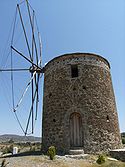- Datça Peninsula
-
The Datça Peninsula is an 80 km-long, narrow peninsula in southwest Turkey separating the Gulf of Gökova to the north from the Gulf of Hisarönü to the south. The peninsula corresponds almost exactly to the administrative district of Datça, part of Muğla Province. The town of Datça is located at its half-way point.
In the early 20th century, it was called the Reşadiye Peninsula [1]; other names include the Dorian or Cnidos Peninsula or the Chersonisos Cnidia.
Contents
Main features
The eastern half of the peninsula is bare, mountainous and scarcely inhabited. In the middle of the peninsula, centered around the town of Datça, is the peninsula's largest area of good land, extending towards the southwest of its median isthmus dividing the two halves of the land mass. The western part is also mountainous, rising in places over 1,000 meters, but has towards its western end on the south side a considerable extent of well-watered land reaching to the coast at Palamutbükü locality and supporting a group of villages known collectively as Betçe (the five villages). [2]
At the tip of the peninsula in its extreme west is the locality called Tekir, marked by Cape Deveboynu, formerly Cape Crio/Kriyo. The cape in itself is a small peninsula which is nearly an island, connected to the mainland by a low, 100m-wide spit of land; in antiquity it was a man-made causeway. The ancient name of the island was Triopion, after Triopas, the legendary founder of Knidos.
The peninsula's eastern end is Bencik Cove, about 1.5 km in length and sometimes referred to as a fjord on the basis of local scales, and at the end of its indentation is the narrow isthmus where Datça Peninsula joins the Anatolian mainland is found. This point is a natural curiosity which offers a wide view of the two gulfs in the north and the south. The locality is called Balıkaşıran (literally, the place where fish may leap across) and is also often used for the portage of small boats [3].
The north coast is low, with vast beaches swept by the meltem winds in the summer. The south coast is dramatically rocky and indented. Because of the natural beauty of its many bays and harbors, the peninsula is often visited by private yachts, and is included in the boat tours usually departing from Bodrum or Marmaris and termed Blue Cruises.
There are ruins of Greek cities both at Datça and Tekir, one or both of which may correspond to ancient Knidos (q.v.).
Names
It was called the Dorian Peninsula because it was settled by Dorian colonists from the Peloponnese.
Both the town and the peninsula of Datça were called Reşadiye for a brief period in the beginning of the 20th century, honoring the penultimate Ottoman Sultan Mehmed V Reşad, and some maps may still refer to the peninsula under this name; today Reşadiye is the name of one of the quarters of the town.
See also
Footnotes
- ^ Not to be confused with the town of Reşadiye in central-northern Anatolia along the valley of the Kelkit River.
- ^ These are; Mesudiye, Sındı, Yakaköy, Yazıköy, Cumalı villages.
- ^ According to Herodotus, during the Persian invasions in 540 BC, the Knidians had sought to dig a canal at this spot as a defensive measure and in order to transform their territory into an island. But an oracle was consulted who reportedly said "If the gods had so willed, they would have made your land an island. Do not pierce the isthmus." Whereupon they surrendered to the Persians.
References
 Datça Peninsula is traced by many small bays
Datça Peninsula is traced by many small bays
- George Ewart Bean (1989). Turkey beyond the Meander ISBN 978-0-7195-4663-1. John Murray Publishers Ltd, London.
- John Freely, The Western Shores of Turkey: Discovering the Aegean and Mediterranean Coasts, Tauris Parke, 2004. ISBN 1-85043-618-5.
- Atlas Antiquus: Taschenatlas der alten Welt, Justus Perthes, 10th ed., 1905.
- Turquie: Guide-Atlas Denoel; Voyages et Civilisations, Denoel, 1973.
External links
- datcarehberi.com in Turkish.
Coordinates: 36°42′26.52″N 27°33′07.10″E / 36.7073667°N 27.551972°E
 Peninsulas of Turkey
Peninsulas of TurkeyMain peninsulas Peninsulas in Trakya Çatalca · GeliboluPeninsulas in Anadolu Related Geographical Features Capes of Turkey · Bays of TurkeyCategories:- Peninsulas of Turkey
- Muğla
Wikimedia Foundation. 2010.


